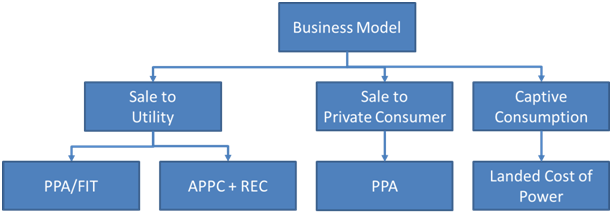Many businesses and individuals approach Solar Mango with the following question: “We own large tracts of land in sunny areas. Should we put up solar power plants?”
Ownership of land might not be the most important starting point, or for that matter, the most important concern.
For any business keen on having MW scale solar power plants, the first and most important question they should ask themselves is: Who will buy the power?
The answer to this question to a significant extent will decide the business and revenue model for the power plant, and also pretty much define the risk and return profiles. To a certain extent, the type of buyer could also determine the financial returns on the project.
A utility scale Solar PV plant can be monetised through the following:
Sale to Utility
Utility usually refers to state power generation or distribution companies (TANGEDCO, APTRANSCO, MAHAGENCO) or other large central power entities such as NTPC.
There are two ways you could sell power to these state utilities.
- PPA/FIT – A Power Purchase Agreement (PPA) is signed with the DISCOM, usually for 25 years, where the price of power (Rs. /kWh) is either determined through competitive bidding or a Feed-In-Tariff (FIT) is fixed by the government. This is the most popular form of power sale in India today
- APPC + REC – The solar plant developer sells power to the DISCOM at Average Pooled Power Cost (APPC) which is fixed by each state, and is usually lower than the PPA/FIT tariff (Madhya Pradesh APPC – Rs. 2.79/kWh; Karnataka APPC – Rs. 3.06/kWh). The developer additionally receives Renewable Energy Certificates (RECs) that can be sold to entities with a Renewable Purchase Obligation (RPO). This model is currently not very popular in India due to poor sales of RECs
Sale to Private Consumer
A private company is free to purchase power from whoever they wish, with only a few constraints attached. You could sell the power generated to private companies as well. This route typically is through a power purchase agreement.
Captive Consumption
For power plant developers who also happen to be running energy intensive businesses, the third route to sell power is through the captive consumption of the solar power generated by their own power plant.
| If you wish to be a developer of MW scale solar power plants, it is important for you to consider all the above three business models to decide the best for you. Solar Mango has a dedicated guide for those interested in developing MW Scale solar power plants, the India MW Solar Advisor. (Link to the MW Solar Advisor – http://bit.ly/1B9eeiv ) |
Related articles
1. Key Customer Segments for MW Scale Power Plants
2. Competitor Scenario for MW Solar Power Plants
3. Drivers & Challenges for MW Scale Power Generation in India
4. Financing Options and Market Strategies for MW Solar Power Plants in India
5. Attractive Segments and Innovations in Rooftop Solar Sector
6. Solar Business Opportunities – An Overview
7. List of High Potential Sectors and Opportunities in the Solar Sector
8. Business Opportunities in Solar Thermal – Heating Applications
9. Emerging Opportunities in Solar Thermal – Refrigeration & Air-Conditioning
10. Business Opportunities in Solar Thermal – Power Applications
11. Business Opportunities in Solar PV Components
12. Manufacturing Opportunities in Solar Energy Sector
13. Ways to Identify Other Potential and Attractive Off-grid Segments
14. Business Opportunities in Diverse Off-grid Applications
15. Innovations and Niche Opportunities in Solar Power Sector
 Skip to content
Skip to content
